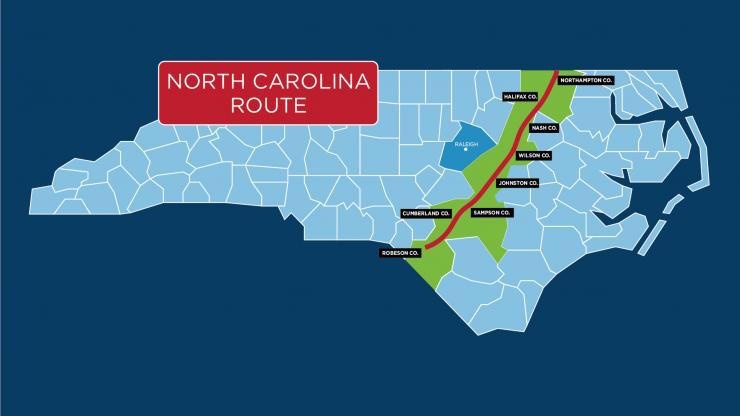INSTITUTE INDEX: The mounting injustice of the proposed Atlantic Coast Pipeline

The Atlantic Coast Pipeline's planned route through Eastern North Carolina would disproportionately impact African-American, Native American and low-income communities. (Map from the N.C. Department of Environmental Quality's website.)
Date on which two separate coalitions of landowners and conservation groups filed requests calling on the Federal Energy Regulatory Commission to reconsider its approval of the Atlantic Coast Pipeline, which would carry fracked natural gas from West Virginia to North Carolina and possibly farther into South Carolina: 11/13/2017
Number of times lead ACP developers Dominion Energy and Duke Energy supplemented their FERC application after the public comment period ended, as noted in the rehearing request filed by the North Carolina-based climate justice advocacy group NC WARN: 18
Number of pages of technical documents on critical issues related to the underground pipeline that were consequently left out of public discussion: thousands
Batches of data the developers added even after FERC had concluded its environmental review: 5
Number of other aspects of the ACP on which NC WARN charges FERC's assessment also "cut corners," including public health and environmental justice: 6
Date on which the NAACP and Clean Air Task Force released a report documenting the environmental injustice of the ACP: 11/14/2017
Of the eight counties along the ACP's proposed route through Eastern North Carolina, number where the median household income is lower than the state's and where the poverty level is higher: 7
Number where the percentage of the population that is African-American exceeds that of the state: 7
While 21.3 percent of North Carolina's population is African-American, percent in those seven counties: 24.3 to 58.4
Percent of the population that's African-American in Northampton County, where the pipeline developers plan to place an air-polluting compressor station: 54.6
Percentage points by which Northampton County's poverty rate exceeds the state's: 13
Percent by which its rate of lung and bronchial cancers exceeds the state's: almost 15
Number of Native American tribal territories the ACP would pass through in North Carolina: 4
Percent of North Carolina's total population that's Native American: 1.2
Percent of the population within a mile of the ACP's route through North Carolina that's Native American: 13.2
Number of times FERC's environmental impact review of the ACP acknowledged the project's disproportionate impacts on Native Americans: 0
Percent of landowners in the pipeline's overall path who have not signed agreements allowing the project to use their property, which the developers plan to seize through eminent domain: 20
Percent by which Duke Energy Carolina's average annual growth projections have been lowered since the ACP was first proposed in 2014: 60
Portion of the ACP's $5.5 billion cost that will be passed on to utility customers, even if the demand for the gas never materializes: nearly all
Month in which the developers expect remaining state permits to be issued in West Virginia, Virginia and North Carolina, allowing construction to move forward: 12/2017
Year in which the project, already a year behind scheduled, expects to begin moving gas: 2019
(Click on figure to go to source.)
Tags
Sue Sturgis
Sue is the former editorial director of Facing South and the Institute for Southern Studies.
